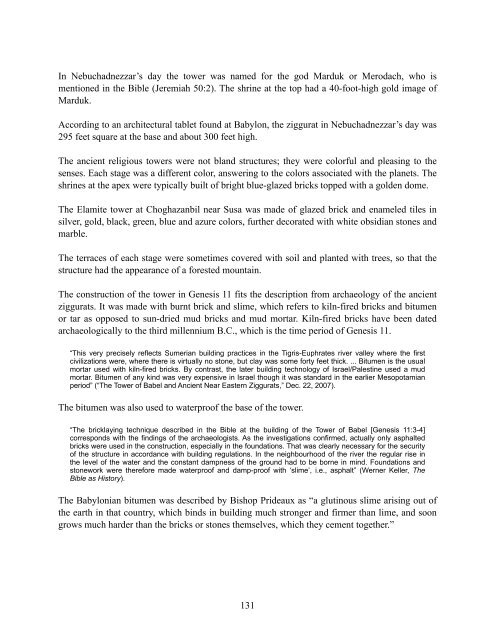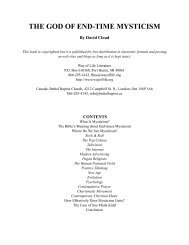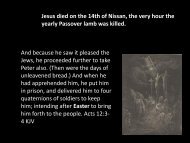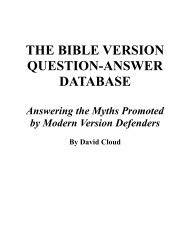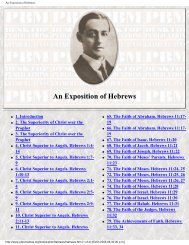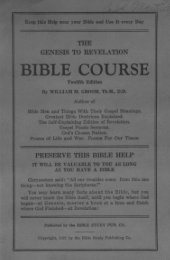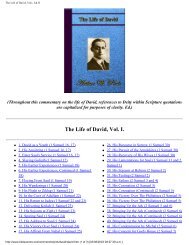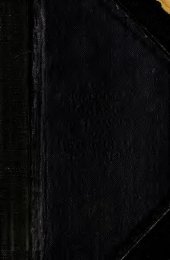- Page 3 and 4:
CONTENTSCopyright and Distribution
- Page 5 and 6:
SUGGESTIONS FOR TEACHERS ANDPRIVATE
- Page 7 and 8:
THE BIBLE CRITICS WERE WRONGIt is t
- Page 9 and 10:
INTRODUCTION TO THE COURSE1. What r
- Page 11 and 12:
To prepare you to challenge unbelie
- Page 13 and 14:
e reasoned into belief in God throu
- Page 15 and 16:
from the creation of the world are
- Page 17 and 18:
of gaining the release of his capti
- Page 19 and 20:
The Bible says that to be saved a m
- Page 21 and 22:
THE BIBLE21
- Page 23 and 24:
This is the foundational passage on
- Page 25 and 26:
It is God’s revelation (v. 10). R
- Page 27 and 28:
Beginning with the first century it
- Page 29 and 30:
The Bible was multiplied and went i
- Page 31 and 32:
The reason that unbelievers cannot
- Page 33 and 34:
12. What did Peter mean when he sai
- Page 35 and 36:
THE BIBLE’S PROOFMEMORY VERSES: A
- Page 37 and 38:
mocked by the people (Psa. 22:6-8 -
- Page 39 and 40:
stars with the naked eye, but the v
- Page 41 and 42:
Frank Morison, a lawyer, journalist
- Page 43 and 44:
8. What are five specific things ab
- Page 45 and 46:
The Masoretic Hebrew text was prese
- Page 47 and 48:
Introductory PointsTHE BIBLE’S DI
- Page 49 and 50:
Third, obedience is required (John
- Page 51 and 52:
allow the context to rule. False te
- Page 53 and 54:
Following are three reasons why we
- Page 55 and 56:
consideration are the following fac
- Page 57 and 58:
that his seed could not inherit the
- Page 59 and 60:
JESUS CHRIST59
- Page 61 and 62:
The New Testament is the most copie
- Page 63 and 64:
* His small band of disciples multi
- Page 65 and 66:
“John’s Gospel is characterized
- Page 67 and 68:
Some say the body was stolenThis wa
- Page 69 and 70:
Some say the disciples made up the
- Page 71 and 72:
“All that Christianity asks of me
- Page 73 and 74:
4. Many have believed. The Bible is
- Page 75 and 76:
ISRAEL IN PROPHECY☛ A PowerPoint
- Page 77 and 78:
Israel’s very land is a powerful
- Page 79 and 80: Ezekiel is told that Israel will be
- Page 81 and 82: Israel’s spiritual blindness is e
- Page 83 and 84: ARCHAEOLOGY☛ NOTE TO TEACHERSWe r
- Page 85 and 86: The Bible is like a very old friend
- Page 87 and 88: Thus, we would not expect to find e
- Page 89 and 90: of Ebla, Paolo Matthiae and Giovann
- Page 91 and 92: “pilloried the book as a consumma
- Page 93 and 94: must study the history of the Chose
- Page 95 and 96: (In my experience, Wikipedia should
- Page 97 and 98: Second, similar ceramic types might
- Page 99 and 100: 10. What Psalm describes the world
- Page 101 and 102: ARCHAEOLOGICAL TREASURESCONFIRMING
- Page 103 and 104: Egyptian in hieroglyphic and hierat
- Page 105 and 106: That was before the Code of Hammura
- Page 107 and 108: 23. When was the Code of Hammurabi
- Page 109 and 110: The Ur civilization was skilled in
- Page 111 and 112: Ur’s LiteracyThousands of cuneifo
- Page 113 and 114: Mass Suicide and Human sacrificeBur
- Page 115 and 116: The timetable also fits the biblica
- Page 117 and 118: EGYPT☛ A PowerPoint presentation
- Page 119 and 120: could not longer hide him, she took
- Page 121 and 122: For the king’s pleasure and prote
- Page 123 and 124: 3. Why does it not matter that we c
- Page 125 and 126: the characteristics of Nimrod. A mi
- Page 127 and 128: does not mean that the ancient Baby
- Page 129: The mother-child were a part of the
- Page 133 and 134: outer being about 80 feet wide so t
- Page 135 and 136: In his first raid on the Jewish cap
- Page 137 and 138: 4. The existence of Nebuchadnezzar
- Page 139 and 140: In Sennacharib’s day Nineveh was
- Page 141 and 142: Chariots“In the Bible frequent me
- Page 143 and 144: tell one man named Utnapishtim. Ea
- Page 145 and 146: The capture of Astartu, a city in G
- Page 147 and 148: “[Hezekiah] himself like a caged
- Page 149 and 150: “how is she become a desolation,
- Page 151 and 152: 23. What does it depict?24. What He
- Page 153 and 154: “It is generally accepted that Mo
- Page 155 and 156: The roof of the museum is in the sh
- Page 157 and 158: EVIDENCE AT MEGIDDOThe hill of Megi
- Page 159 and 160: Since the early 1960s extensive arc
- Page 161 and 162: Solomon’s Temple (“The World of
- Page 163 and 164: 37. What is the significance of the
- Page 165 and 166: Critics said that Luke was wrong in
- Page 167 and 168: EVOLUTION INTRODUCTION1. One doesn
- Page 169 and 170: 3. Beware of the myth that the Bibl
- Page 171 and 172: In 1922, William Jennings Bryan war
- Page 173 and 174: sure to be another one into which i
- Page 175 and 176: “Progressing in my studies, I slo
- Page 177 and 178: the Creation (Mk. 13:19), Adam and
- Page 179 and 180: To this date is added the time of t
- Page 181 and 182:
Darwin pointed to the variety among
- Page 183 and 184:
divine creation a priori. Astrophys
- Page 185 and 186:
“As Michael Behe pointed out in a
- Page 187 and 188:
earth by aliens] is that he judges
- Page 189 and 190:
Juan Arsuaga candidly advises,“..
- Page 191 and 192:
teaching on things such as judgment
- Page 193 and 194:
A HISTORY OF EVOLUTIONIn this secti
- Page 195 and 196:
Erasmus believed that everything ha
- Page 197 and 198:
Charles’ father wanted him to be
- Page 199 and 200:
“He cut himself off, ducked parti
- Page 201 and 202:
present at his deathbed. ... He nev
- Page 203 and 204:
The X-Club published its own period
- Page 205 and 206:
Insanity and depression run deeply
- Page 207 and 208:
ICONS OF EVOLUTION☛ A PowerPoint
- Page 209 and 210:
iology has a central canon, you hav
- Page 211 and 212:
Some clever Darwinists can create a
- Page 213 and 214:
SUMMARY OF THE EVIDENCE AGAINST NAT
- Page 215 and 216:
information that will code for adap
- Page 217 and 218:
We would warn our readers to beware
- Page 219 and 220:
only thing that has been produced i
- Page 221 and 222:
“No fossil is buried with its bir
- Page 223 and 224:
The massive worldwide fossil beds a
- Page 225 and 226:
The Devonian Thunder Bay Limestone
- Page 227 and 228:
The fossilization that is evident t
- Page 229 and 230:
This quote debunks the evolutionary
- Page 231 and 232:
“The oldest bat fossils, belongin
- Page 233 and 234:
University: “This shows once agai
- Page 235 and 236:
CoalEvolutionists have long used th
- Page 237 and 238:
16. How could a fragile creature li
- Page 239 and 240:
an engineer and actually look at th
- Page 241 and 242:
6. What is the major assumption und
- Page 243 and 244:
Jonathan Wells, Ph.D. in cell biolo
- Page 245 and 246:
Since the 1940s, Darwin’s finches
- Page 247 and 248:
Practically every biology textbook
- Page 249 and 250:
malformations. Their Herculean effo
- Page 251 and 252:
human arms, hands, legs, and feet.
- Page 253 and 254:
In 1987, Oxnard did an extensive co
- Page 255 and 256:
In fact, the overall impression tha
- Page 257 and 258:
2. The Lucy creature had ape-like f
- Page 259 and 260:
The horse series was developed by O
- Page 261 and 262:
The reconstructions of Hyracotheriu
- Page 263 and 264:
It was exposed first by Ludwig Ruti
- Page 265 and 266:
The embryo chart is actually a vain
- Page 267 and 268:
Great spiritual and moral damage ca
- Page 269 and 270:
In spite of the nebulous and highly
- Page 271 and 272:
The main product of the Miller expe
- Page 273 and 274:
Even a “simple” E. coli bacteri
- Page 275 and 276:
11. Michael Pitman says that “ear
- Page 277 and 278:
It is important to note that the sa
- Page 279 and 280:
whale, whereas there is absolutely
- Page 281 and 282:
These are only a few of the problem
- Page 283 and 284:
Raging Controversy - No ConsensusAr
- Page 285 and 286:
Evolutionary AssumptionApart from e
- Page 287 and 288:
Bellows-like lungs would have to ev
- Page 289 and 290:
mountains, flying more than five an
- Page 291 and 292:
What If Some Dinosaurs Had Feathers
- Page 293 and 294:
6. Paul Chambers says, “Most now
- Page 295 and 296:
3. Has the sand always been falling
- Page 297 and 298:
Typically they select dates they pr
- Page 299 and 300:
We would ask another question: What
- Page 301 and 302:
7. The time it takes for one half o
- Page 303 and 304:
which is about a half inch long, mi
- Page 305 and 306:
It begins life as a tiny, brilliant
- Page 307 and 308:
During the pupa stage, the creature
- Page 309 and 310:
“You have a great big orchestra i
- Page 311 and 312:
walls that are designed to cause in
- Page 313 and 314:
extinct 240 million years ago. It i
- Page 315 and 316:
Indiana, New York, Oklahoma, Ohio,
- Page 317 and 318:
“The absence of transitional inte
- Page 319 and 320:
“In my opinion the history of the
- Page 321 and 322:
Evolutionist Freeman Dyson said,
- Page 323 and 324:
flowers. Jesus spoke of their beaut
- Page 325 and 326:
It has been claimed that a group of
- Page 327 and 328:
Man will be guilt-ridden.The Bible
- Page 329 and 330:
Of course, modern science has confi
- Page 331 and 332:
7. The fossil record disproves evol
- Page 333 and 334:
NOAH’S ARK AND THE WORLDWIDEFLOOD
- Page 335 and 336:
that destroyed all mankind, except
- Page 337 and 338:
inside their abdomens. The fossiliz
- Page 339 and 340:
Eroding sediments here, redepositin
- Page 341 and 342:
1. The Bible says that God instruct
- Page 343 and 344:
15. The key to answering the charge
- Page 345 and 346:
I don’t like to do that type of w
- Page 347 and 348:
Trust in God (2 Timothy 2:25-26).On
- Page 349 and 350:
Explain the light that God has give
- Page 351 and 352:
It is true that we should always tr
- Page 353 and 354:
On the subject of creation science/
- Page 355 and 356:
and He promises that He will receiv
- Page 357 and 358:
The atheist mocks and ridicules.Ath
- Page 359 and 360:
vision of the ram and goat in Danie
- Page 361 and 362:
We could give nearly endless exampl
- Page 363 and 364:
Use the “you are a rock” approa
- Page 365 and 366:
MISCELLANEOUS QUESTIONSANSWERED1. D
- Page 367 and 368:
LEE SPETNER, author of Not By Chanc
- Page 369 and 370:
is believing in something invisible
- Page 371 and 372:
“Wherefore putting away lying, sp
- Page 373 and 374:
man to live in and provided for his
- Page 375 and 376:
“I love them that love me; and th
- Page 377 and 378:
to this doctrine, Jesus and “the
- Page 379 and 380:
against stealing and bribery and ot
- Page 381 and 382:
ecause they would not submit to the
- Page 383 and 384:
In fulfillment of these prophecies,
- Page 385 and 386:
A book that can help you understand
- Page 387 and 388:
10. The Bible’s teaching about sa
- Page 389:
COPYRIGHT AND DISTRIBUTIONNOTICEThi


